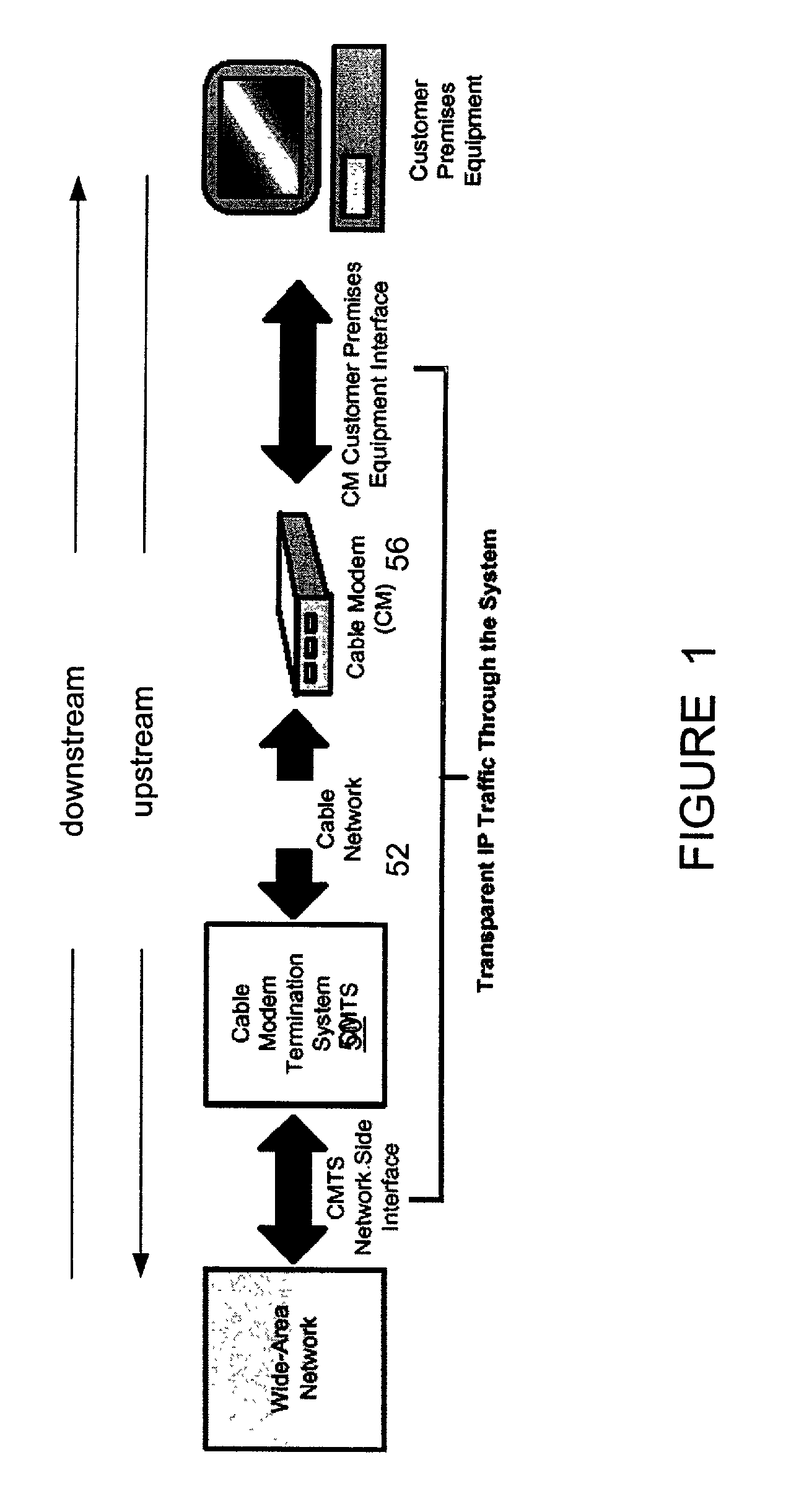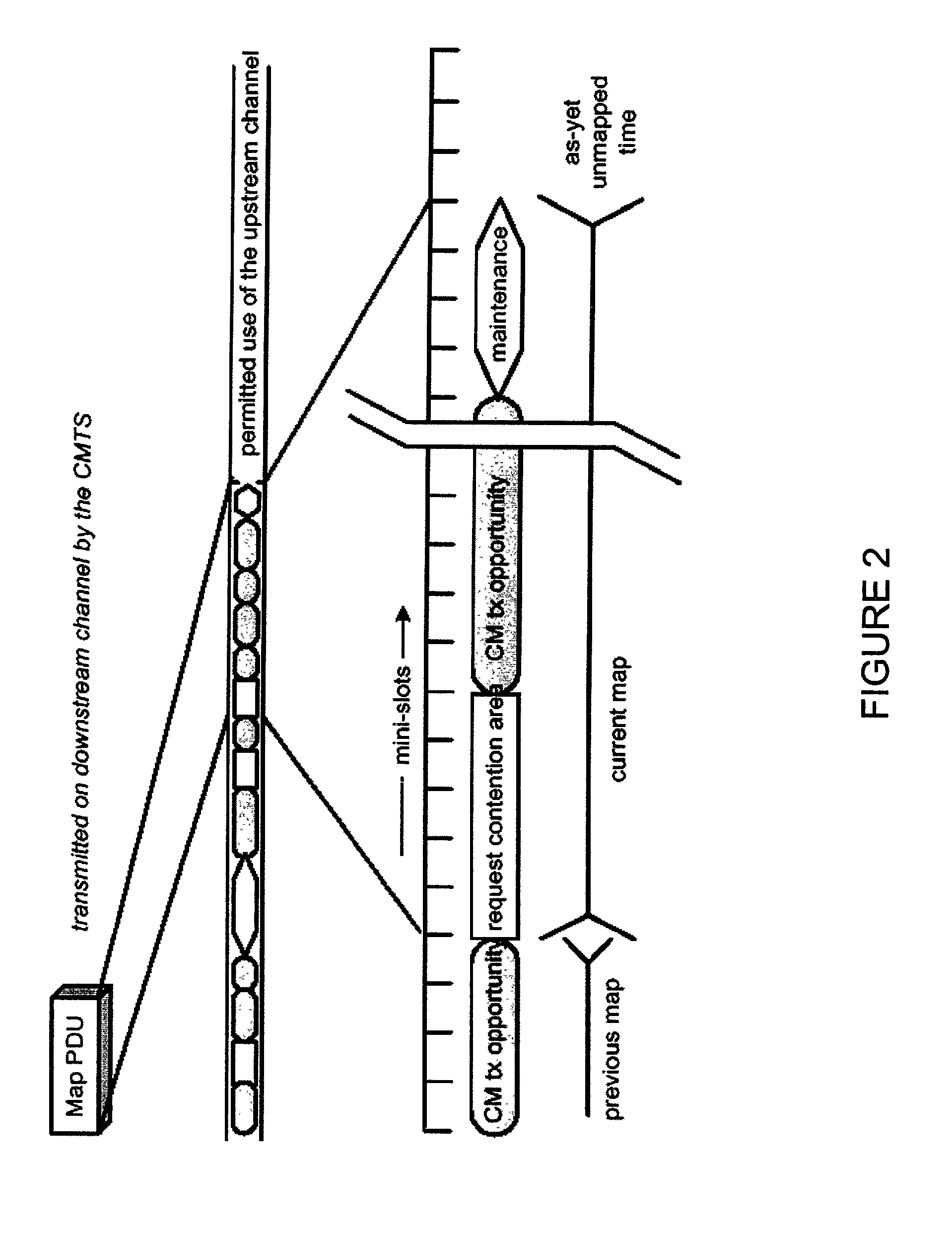However, the
Service Flow concept allows for more complex cable modems to be developed which support for multiple service classes while supporting
interoperability with more basic modems.
With these more complex cable modems, it is possible that certain Service Flows will be configured in such a way that they cannot carry all types of traffic.
That is, they may have a maximum packet size limitation or be restricted to small fixed size unsolicited grants.
Furthermore it might not be appropriate to send other kinds of data on Service Flows that are being used for Constant
Bit Rate (CBR)-type applications.
If the CMTS does not immediately respond with a Data Grant, the cable modem is able to unambiguously determine that its request is still pending because the CMTS will continue to issue a Data Grant Pending in every MAP for as long as a request is unsatisfied.
This would be wasteful in both downstream bandwidth and in
processing time within the cable modems.
At step 3, the request may collide with requests from other cable modems and be lost.
At one extreme, the CMTS may choose to set up the Data Backoff Start and End to emulate an
Ethernet-style back-off with its associated simplicity and distributed nature, but also its fairness and efficiency issues.
This will result in the cable modem only using unsolicited data grants for upstream transmission.
This will result in the cable modem using only
unicast request opportunities in order to obtain upstream transmission opportunities (the cable modem could still use unsolicited data grants for upstream transmission as well).
This results in the cable modem using only
unicast request opportunities in order to obtain upstream transmission opportunities.
However, the cable modem will use unsolicited data grants for upstream transmission as well.
This will result in the cable modem using contention request opportunities as well as
unicast request opportunities and unsolicited data grants.
This will result in the cable modem using contention request opportunities as well as unicast request opportunities and unsolicited data grants.
Transport of cells in UBR service is not necessarily guaranteed by mechanisms operating at the
cell level.
There are two problems with such kind of a use: the first one is that the time it takes the eMTA to send a packet, and the problem of using a contention are that is shared with the data packets.
The first issue is that assuming there is no contention on the
Cable Modem requests, the time it takes the packet to be transmitted. FIG. 11, FIG. 12 and FIG. 13 show all the messages that are exchanged between the eMTA and the CMTS for transmission of the call signaling packets when using broadcast request opportunities.
Further, it takes 1
millisecond for the message to propagate to the CMTS.
For the second issue it has been shown that the sharing of request / contention areas with
data transmission introduces a very big
delay to the
system that during congestion intervals it may not be acceptable.
It is possible that such is not applicable to a modern scheduler in which engineers the number of contention / requests to the traffic usage pattern.
But the issue still remains and since the use of request / contention area cannot be prioritized between SIDs that are on different cable modems, meaning that it is not possible for CMTS to give call signaling packets a preferential treatment.
The problem with this kind of scheduling is that since the CMTS cannot guess which cable modems are in contention in a contention / request opportunity, when a contention is detected, the cable modem should revert to the
Unicast Polling Opportunities, which makes the use of the request / contention opportunities during high traffic.
The only issue with such a method is that the cable modem will use the truncated binary
exponential backoff algorithm to pick which opportunity it will utilize, and there are only one global data backoff start and data backoff end settings.
If one uses the same values that is being used for the
broadcast data opportunities or any of the other contention request opportunities then this would cause an unnecessary bandwidth waste.
The problem with using Priority Requests is as follows.
This implies that a minimum of 15% of the upstream mini-slots will be wasted due to inability of the scheduler to send
bandwidth allocation MAP messages with different data backoff settings.
A challenging aspect of
DOCSIS CMTS design are problems with scheduling channels and service flows generated therein based upon applications that use the bandwidth provided to them by the cable modem
system.
For instance, the typical cable modem will have no idea if the application requesting a service flow is an HTTP application or a
Voice over IP The main challenge for the CMTS is to meet the
delay, bandwidth and other requirements of service flow
quality of service encodings by scheduling the
data transmission opportunities.
 Login to View More
Login to View More  Login to View More
Login to View More 


